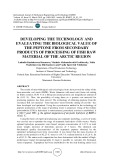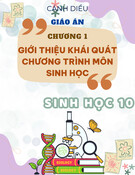
http://www.iaeme.com/IJMET/index.asp 1880 editor@iaeme.com
International Journal of Mechanical Engineering and Technology (IJMET)
Volume 10, Issue 03, March 2019, pp. 1880-1893. Article ID: IJMET_10_03_191
Available online at http://www.iaeme.com/ijmet/issues.asp?JType=IJMET&VType=10&IType=3
ISSN Print: 0976-6340 and ISSN Online: 0976-6359
© IAEME Publication Scopus Indexed
DEVELOPING THE TECHNOLOGY AND
EVALUATING THE BIOLOGICAL VALUE OF
THE PEPTONE FROM SECONDARY
PRODUCTS OF PROCESSING OF FISH RAW
MATERIAL OF THE ARCTIC REGION
Ludmila Kazimirovna Kuranova, Vlasimir Aleksandrovich Grokhovsky, Yulia
Viacheslavovna Zhivlyantseva and Vasily Igorevich Volchenko
Department of Food Production Technology
Institute of Natural Science and Technology
Federal State Educational Institution of Higher Education "Murmansk State Technical
University"
Murmansk, Russian Federation
ABSTRACT
The results of microbiological and toxicological tests have proved the safety of the
bone-muscular cod waste (BMW). Waste (humerus with meat cuts) from cod cutting
on fillets contains 18,95 % of a full-grade animal protein and insignificant amount of
fat (0.15 %). Thus, the possibility of using them as a protein raw material for
producing peptones has been proved. The technology of obtaining peptone from the
secondary fish raw material - bone-muscular waste from the cutting of cod fish - has
been developed and optimized. Using the cryoextrusion method in the technology of
peptone production at the stage of grinding waste is proposed. Using of the enzyme
(protosubtilin G3X) in hydrolysis is substantiated; proteolytic activity is established, it
is 560,77 μmol TYR / g, the optimal temperature of enzymatic hydrolysis of BMW is
(45±1) ˚С.
Using the theory of experiment planning and computer modeling, a series of works
was carried out to optimize the stage of enzymatic hydrolysis of fish wastes. Nearly
optimal hydrolysis parameters were found: enzyme concentration of 1,33 % to total
waste weight, duration of hydrolysis process of 3 hours. The chemical and
biochemical quality characteristics of the enzymatic peptone obtained by the
optimized technology have been researched. It was found that the mass fraction of
protein in the product is of 92,27 %, water is of 4,7 %, sodium chloride is of 2,6 %, fat
is of 0,3 %. The amino acid composition has been determined with the method of high-
performance liquid chromatography. It made it possible to calculate the biological
value of peptone. Tryptophan has been established to be the only limiting amino acid





















